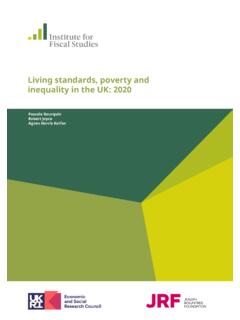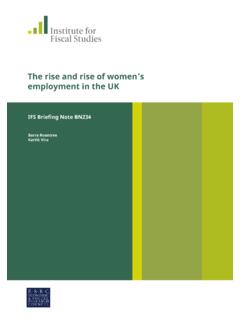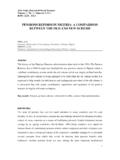Transcription of The history of state pensions in the UK: 1948 to 2010
1 Institute for Fiscal Studies, 2010 1 The history of state pensions in the UK: 1948 to 2010 Antoine Bozio, Rowena Crawford and Gemma Tetlow* Institute for Fiscal Studies Abstract This Briefing Note describes state pension provision in the United Kingdom from the inception of the basic state pension in 1948, following the Beveridge Report, to pensions Act 2007 and the plans of the Conservative/Liberal Democrat coalition government. The main objective is to provide a comprehensive description of the rules that currently determine pension benefits as well as those that have been in place in the past.
2 However, we also provide a brief historical overview of the dilemmas facing policymakers when contemplating pension reforms and a summary of the most recent reforms. The history of the UK pension system is the story of a mainly non-contributory system, periodically tempted by the higher replacement rate of social insurance schemes, but always frightened once the costs become apparent. Recent reforms have tilted the system further in the direction of a universal flat-rate benefit, abandoning any social insurance design. This confirms that the main objective of the UK state pension system is to reduce poverty at old age.
3 These flat-rate pensions will also reduce the reliance of the system on means-tested benefits, somewhat reinforcing the Beveridgean design of the system. Given these clarifications, it is unfortunate that the latest reforms have still sought to maintain much of the complex structure of the pre-existing system instead of reforming and rationalising it. However, once issues of transition have been dealt with, there may yet be scope for simplifying the presentation of the rules. * This paper was funded by the ESRC Centre for the Microeconomic Analysis of Public Policy at the Institute for Fiscal Studies (RES-544-28-5001).
4 The authors would like to thank Carl Emmerson for useful comments on an earlier draft of this Briefing Note and Judith Payne for copy-editing. All remaining errors are the responsibility of the authors. Addresses for correspondence: ISBN: 978-1-903274-77-4 Institute for Fiscal Studies, 2010 2 Contents 1. Introduction .. 4 2. Overview of 60 years of state pensions in the UK .. 6 What are state pensions meant to achieve? .. 6 In the beginning was Beveridge .. 7 The temptation of social insurance .. 9 Means-tested benefits: mitigating relative poverty.
5 10 Looking forward: toward a flat-rate state pension system? .. 10 3. The basic state pension .. 12 Overview of the basic state pension .. 12 Entitlement based on one s own contribution history : category A pensions .. 15 Entitlement based solely on one s partner s contribution history : category B pensions .. 22 Additions to the basic state pension .. 26 Receiving the basic state pension .. 29 4. Earnings-related benefits .. 33 Graduated retirement benefit (1961 to 1975) .. 33 state Earnings-Related pension Scheme (1978 to 2002).
6 34 state second pension .. 38 Deferral of additional pension .. 42 Inheriting rights to additional pension .. 42 Contracting out .. 45 5. Non-contributory, non-means-tested benefits .. 48 Category C pension .. 48 Category D pension .. 48 Christmas bonus .. 49 Winter fuel payments .. 49 Over-75s TV licence .. 50 6. Means-tested benefits for pensioners .. 51 Means-tested pensions and National Assistance (1948 to 1966) .. 51 Supplementary benefits (1966 to 1988) .. 51 Income support (1988 to 2003) .. 52 pension credit (from October 2003).
7 53 Other means-tested benefits .. 58 Institute for Fiscal Studies, 2010 37. Overview of the post-2007 state pension system .. 59 Pre-2007 policy and implications for earnings replacement .. 59 What will the new system look like? .. 61 Post-2007 policy and earnings replacement .. 62 8. Total government spending on pensioners: history and projections .. 64 Total spending on pensioners .. 64 Growth in the number of pensioners .. 66 Spending per pensioner .. 67 9. Conclusions .. 68 Appendix A. state pension ages .. 70 Appendix B.
8 Earnings credits .. 72 Appendix C. Disregards for the purposes of pension credit .. 74 Appendix D. Abbreviations .. 76 References .. 77 Institute for Fiscal Studies, 2010 4 The scheme proposed here is in some ways a revolution, but in more important ways it is a natural development from the past. It is a British revolution. Sir William Beveridge1 1. Introduction pension provision inherently has a historical dimension. There is a gap of at least a few decades between the time contributions are first paid and the time benefits are received, with rights accruing in the interim.
9 Then benefits are paid for another one or two decades according to rules that are usually no longer in place and forgotten to all but a few specialists. It should be mentioned from the start that this Briefing Note is not a history of pension policy as it might be understood by historians or political scientists. The first objective is to provide practical information on pension rules to allow researchers, and especially economists, to be able to compute pension rights, measure incentives and assess the impact of pension provision on individual behaviour.
10 As such, this document will not dwell on the political debate about pensions . The UK system of support for pensioners that exists today is a complicated one, with four main components the basic state pension (BSP), earnings-related benefits, flat-rate non-contributory benefits and means-tested benefits. Each of these has been tinkered with or reformed over time and, as new systems and rules have been introduced, entitlements under previous systems have sometimes been preserved. This means that individuals retiring today can still be affected by pension systems and rules that existed over 40 years ago.











